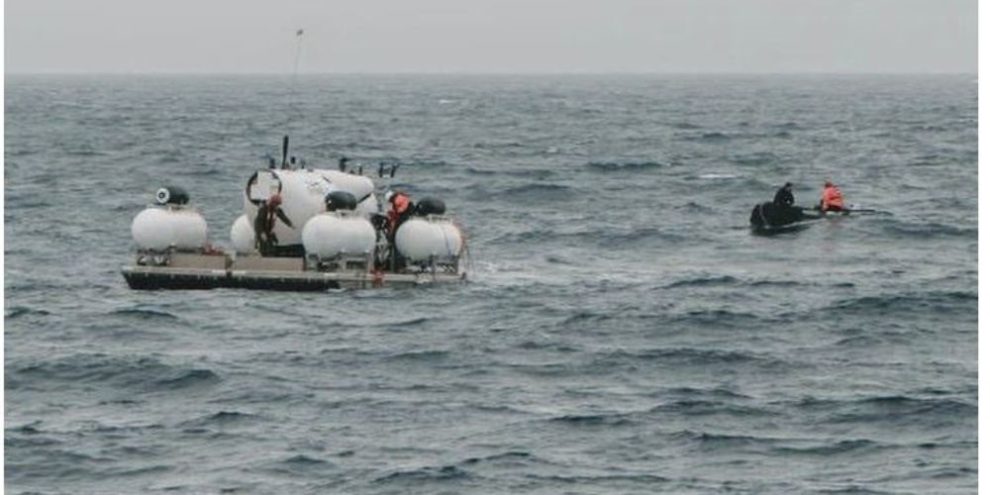
By Keith Doucette in Halifax
An underwater vehicle joined the search of a remote patch of ocean south of Newfoundland Tuesday for a submersible that vanished with five people on board during a dive to the wreck of the Titanic.
The search, in an area about 700 kilometres south of St. John’s, N.L., is a race against time to find the vessel that began its descent to the ocean floor Sunday with a 96-hour supply of oxygen.
Capt. Jamie Frederick of the U.S. Coast Guard estimated the crew of the Titan had roughly 40 hours of oxygen left as he briefed reporters Tuesday at 1 p.m.
“To date … search efforts have not yielded any results,” Frederick said.
He said the Deep Energy, a Bahamas-flagged cable layer, was in the search area with the Titan’s surface launch ship Polar Prince and was conducting an underwater search with its remotely operated vehicle, or ROV.
The ROV has limited capability but does have a camera, Frederick said. “They commenced an ROV dive at the last known position of the Titan in the approximate position of the Titanic wreck. That operation is ongoing.”
In addition, a Royal Canadian Air Force Aurora patrol aircraft was conducting overhead surveillance while several military Hercules planes and another Aurora were expected on scene later in the day and into the evening.
Frederick said the Canadian Coast Guard vessel John Cabot was expected to arrive Tuesday evening and several other Canadian and U.S. Coast Guard ships were en route. Heavy salvage equipment from the U.S. military was also expected to be flown to St. John’s before being transported to the search area, he said.
“Logistically speaking it’s hard to bring assets to bear. It takes time, it takes co-ordination and then we’re dealing with a surface search and a subsurface search, and that makes it an incredibly complex operation,” said Frederick.
Dr. Ken LeDez, an anesthesiologist with an expertise in hyperbaric and diving medicine, said the submersible’s occupants are in a dire situation, especially if the vehicle has lost power. “I feel the odds are stacked against them,” LeDez, of Memorial University in St. John’s, said in an interview. “My thoughts just turn to the kind of experience that they must be having right now."
If the vessel lost power, the five would be battling decreasing oxygen supplies and increasing carbon dioxide concentrations, all in complete darkness, said LeDez. The temperature inside the chamber would also likely be plummeting if the loss of electricity wiped out their heat source.
Lt.-Cmdr. Len Hickey, of the Joint Rescue Coordination Centre in Halifax, said HMCS Glace Bay of the Royal Canadian Navy was also heading to the scene with a medical team specializing in dive medicine, but it wasn't expected to arrive until midday Thursday.
Those on board the submersible have yet to be formally identified by authorities, but their names have been confirmed by other sources.
British businessman Hamish Harding, who lives in Dubai in the United Arab Emirates, was one of the mission specialists, according to Action Aviation, a company for which Harding serves as chairman. Also on board were Pakistani nationals Shahzada Dawood and his son Suleman, according to a family statement sent to The Associated Press.
French explorer and Titanic expert Paul-Henry Nargeolet was on board, according to David Gallo, a senior adviser for strategic initiatives and special projects at RMS Titanic Inc.
Stockton Rush, the CEO of OceanGate Expeditions, which owns the submersible, is also part of the crew, a spokesman for the company confirmed Tuesday.
Toronto-based physician and undersea explorer Joe MacInnis said in an interview Tuesday his heart is with his friend Nargeolet, with whom he dived to the Titanic in 1987 in a French submersible.
“It’s red-zone time, whatever's going on. And this is where the cool, calm, collected leadership of P.H. Nargeolet will be at play," MacInnis said. "I mean, he will be the leader in this kind of crisis moment where they're all trying to figure out (what to do), assuming that they're still alive. He knows that the world is trying to come down and rescue them if they're on the bottom."
Alistair Greig, a professor of marine engineering at University College London, said submersibles typically have a drop weight, which is "a mass they can release in the case of an emergency to bring them up to the surface using buoyancy."
"If there was a power failure and/or communication failure, this might have happened, and the submersible would then be bobbing about on the surface waiting to be found," Greig said.
Another scenario is a leak in the pressure hull, in which case the prognosis is not good, he said. "If it has gone down to the seabed and can't get back up under its own power, options are very limited," Greig said. "While the submersible might still be intact, if it is beyond the continental shelf, there are very few vessels that can get that deep, and certainly not divers."
This is the third year OceanGate has led expeditions to chronicle the deterioration of the Titanic, which struck an iceberg and sank in 1912, killing all but about 700 of the roughly 2,200 passengers and crew. The expeditions include archeologists and marine biologists, but the company also brings people who pay to come along. They take turns operating sonar equipment and performing other tasks in the submersible. OceanGate's website described the "mission support fee" for the 2023 expedition as US$250,000 a person.
This report by The Canadian Press was first published June 20, 2023.
— With files from Sarah Smellie in St. John's, N.L., and The Associated Press





